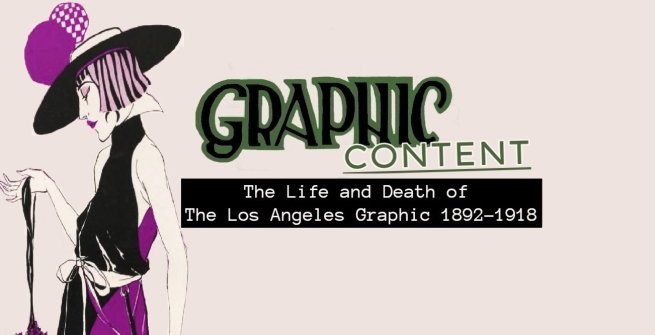This is part one of a seven-part blog series exploring the long-forgotten Los Angeles arts & culture magazine, The Graphic. The Los Angeles Public Library owns what is likely the most complete collection of this magazine anywhere and our participation in California Revealed means that we can share this rare and unique resource with the world.
Part I: Resurrecting a Society Journal
One of the joys that both professional and amateur historians experience is finding new resources that compound our understanding of local history. When I have free time (which isn’t often), I like to scour Google Books and the Internet Archives for digital resources that might tell me about more niche stories within local history. My casual, intermittent search became more focused when a professor at a local college reached out to me, to see if I knew of any digital resources that her Los Angeles History Class might be able to access during the Covid-19 pandemic. Like the Los Angeles Public Library, the campus library was closed and students were reliant on digital resources to advance their scholarship.
I was able to point out a number of library databases and resources but was also looking to provide as many options as possible so I looked to the HathiTrust and the Internet Archive websites. During this search in the Fall of 2020, I discovered a single issue of a magazine called The Graphic on the Internet Archive. It was my first encounter with this publication and you can imagine my surprise when I noticed that the Los Angeles Public Library was the source of this digitized magazine from 1906. I immediately reached out to colleagues to learn more and what I found out was that this issue of The Graphic was part of a larger project that had been going on for some time but had been placed on hold by the pandemic. While my inner researcher waited for the remaining 719 issues to be scanned and uploaded, I took the time to learn about The Graphic’s history and the Library’s involvement in a statewide initiative to make California history resources more accessible to researchers. I’ll detail the history of The Graphic in an upcoming blog series but, for now, I wanted to focus on what it took to bring The Graphic into the public sphere. Ultimately, it's a story of the value of institutional knowledge, information professionals committed to making our rare and unique resources available, and the support of the state library in maintaining our collective history.
Story, Kenney, Knickerbocker and love for Los Angeles
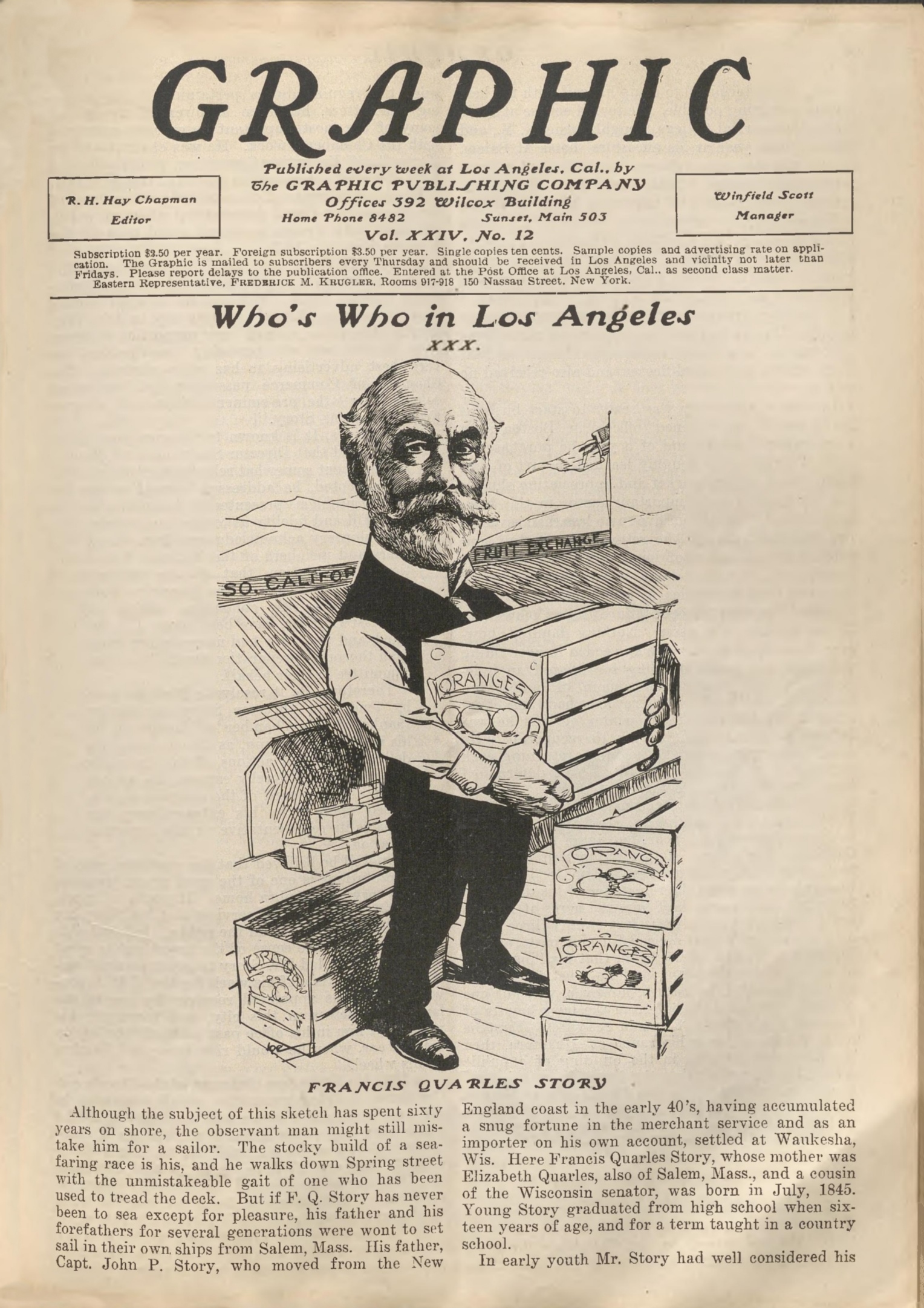
For nearly a year, I studied this solitary issue dated March 24, 1906, with great curiosity. It provided a tantalizing glimpse of life in Progressive Era Los Angeles and included profiles on Francis Quarles Story, the sometime President of the Los Angeles Chamber of Commerce and the California Fruit Growers Exchange, as well as suffragist Elizabeth Kenney, one of the first female attorneys in Los Angeles; though what really caught my attention was an essay written by "John Knickerbocker" (probably a pseudonym) entitled 'As the Stranger Sees Us' because it was a defense of our city:
Why should Los Angeles be thus super sensitive to the stranger’s criticism of its obvious faults and defects? The shortcomings are not comparatively numerous and but few are glaring. The average visitor, of large acquaintance with cities abroad, will credit this city with a minimum of causes for criticism. Compared with large American cities, Los Angeles occupies an enviable position. But in no other city is it popularly regarded as a criminal offense to intimate that there is anything lacking in the elements of urban greatness…Los Angeles is deserving of greater credit for what it has accomplished within the few years of its urban majority than most other American cities that are old enough to be its urban father, grandfather, or even great-grandfather…Pushed by its characteristic zeal and energy of the cultured women of Los Angeles and backed by the progressive spirit of its leading male citizens in all laudable lines of endeavor, Los Angeles is entering upon an era of its history that will eliminate the defects pointed out by its critics.
It was clear that this publication was something that celebrated Los Angeles and the urban metropolis that it was destined to become. This was definitely a resource that deserved a closer look.
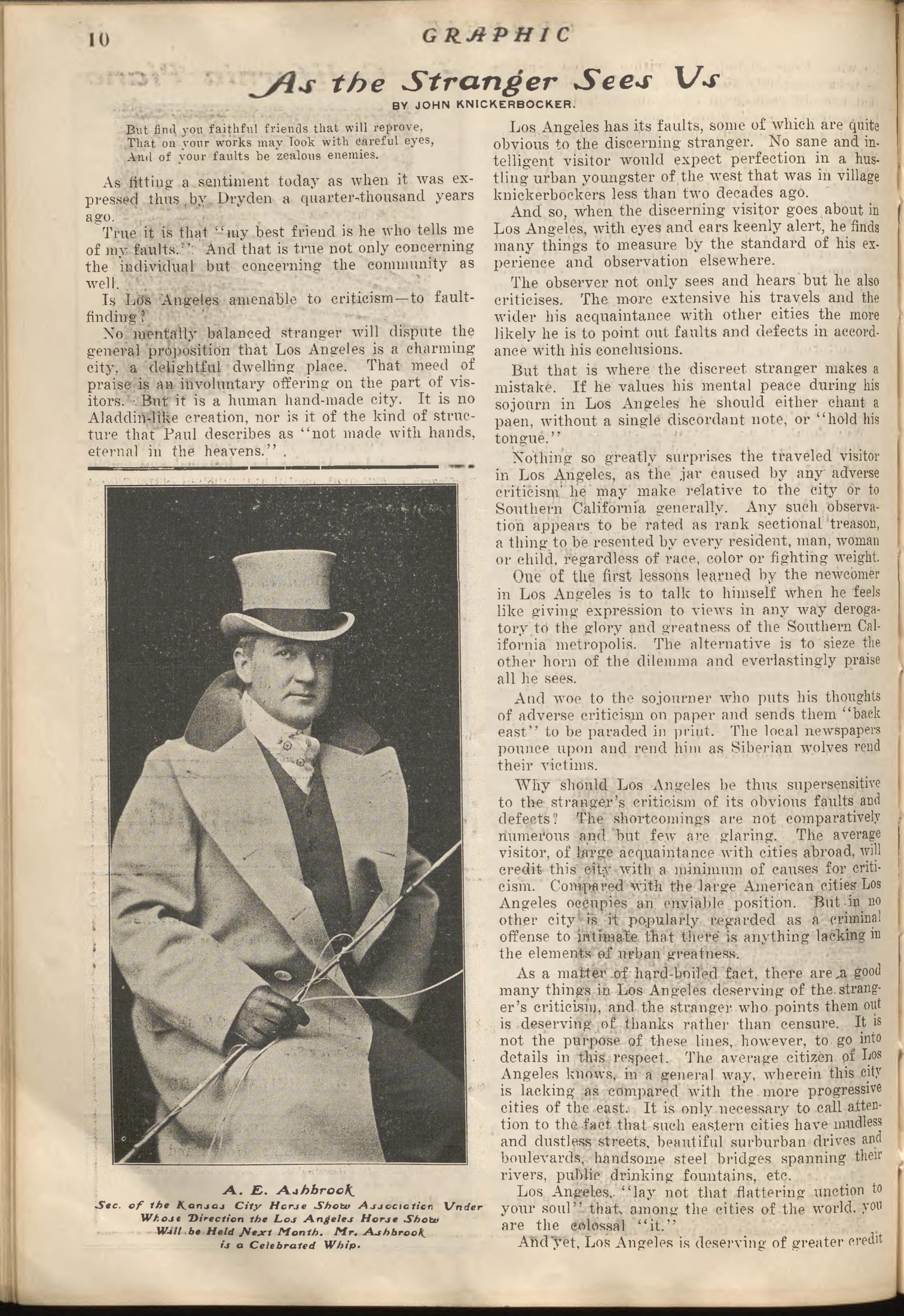
The Graphic was a weekly arts & culture publication that spanned from 1904 to 1918. The magazine was the result of the merger of two publications that had consumed several smaller publications around the turn of the century. The magazine’s formal debut as "The Graphic" commenced in February 1904 and ended on October 24, 1918. The Los Angeles Public Library’s collection does not start until August 1904 but, thereafter, we have a full run of the magazine. The library’s holdings appear to be the most complete collection of this magazine available anywhere. For decades, the Los Angeles Public Library’s collection was kept within the closed stacks of our Special Collections department and was requested on occasion, but the magazine had been largely forgotten. While transferring resources to Special Collections ensures the safety and preservation of those resources, it also adds another layer of distance between the resource and the researcher. Digitization helps to bridge that gap so when the opportunity to digitize such a valuable primary resource presented itself, our librarians opted to pursue it.
California Revealed
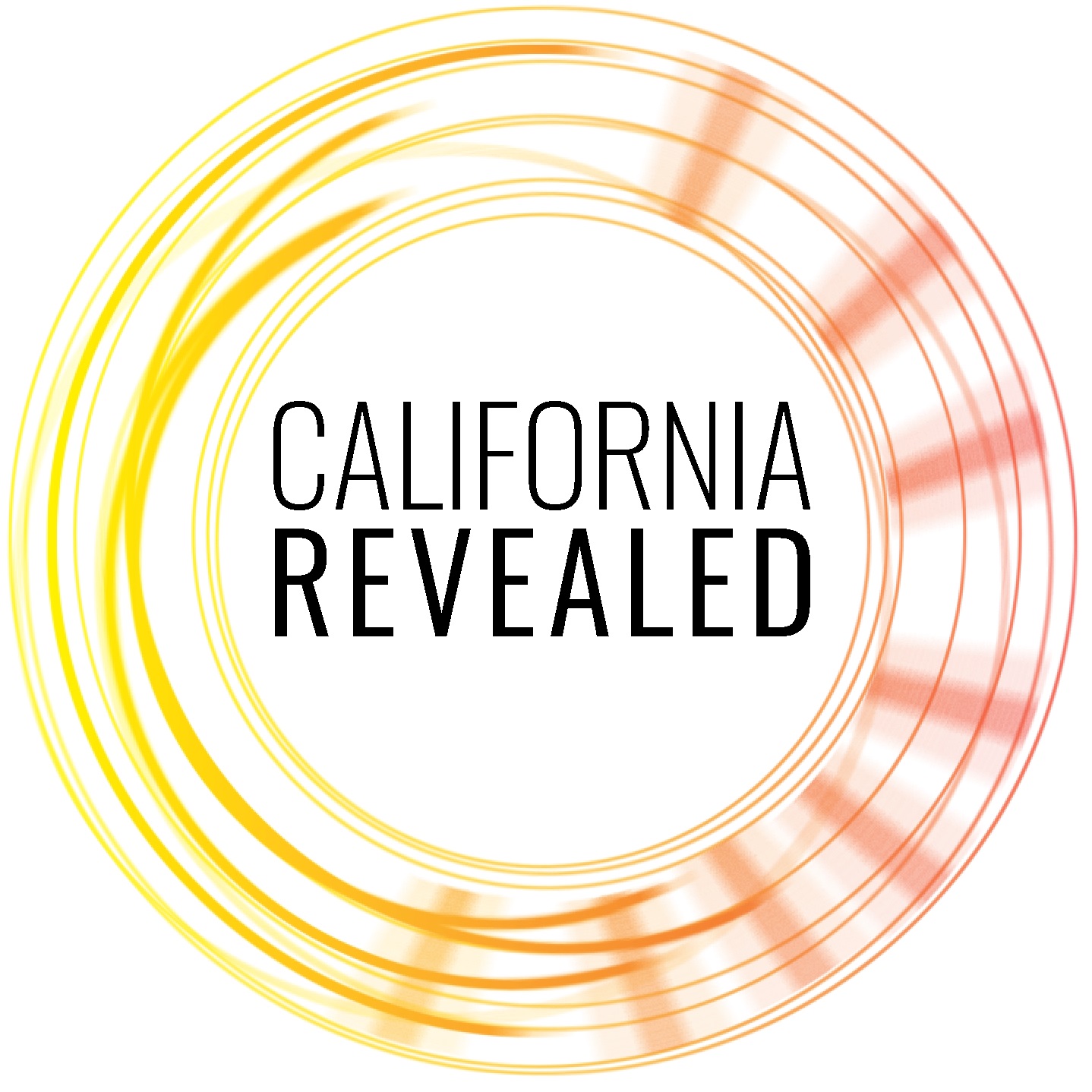
In early 2017, the Los Angeles Public Library’s Digitization & Special Collections Department received word that the California State Library was accepting applications for a statewide initiative to help "heritage organizations digitize, preserve, and provide online access to materials documenting the state’s history, art, and cultures." This initiative, California Revealed, began in 2011 as part of the California State Library’s work to expand the historical narrative of California by helping "regional organizations" (public libraries, archives, museums, historical societies, and community groups) to digitize their resources and provide free and unlimited access through public access points like Calisphere, the Internet Archive, the Digital Public Library of America and/or the Home Movie Registry. Early on, the initiative was focused on audio/visual material but has expanded over the past decade to include almost any unique resource that contributes to a better understanding of our state’s history. An ideal candidate for California Revealed met two requirements: 1) the resource had not previously been digitized, and 2) it was not widely held by other institutions. Because Central Library has, quite literally, millions of resources, leaving one person responsible for identifying said material for California Revealed would be just a bit overwhelming, so, in order to identify these materials, it would be a collaborative effort. Digitization and Special Collections reached out to Central Library subject specialists, asking them to identify prospective resources for California Revealed.
Subject Specialists and Institutional Knowledge
Subject specialists throughout Central Library were asked to survey resources that fell within the purview of their expertise. Here in the History Department, it was our California Subject Specialist, Kelly Wallace, who was tasked with identifying prospective resources. Wallace began to survey holdings within the department but in addition to her daily responsibilities and other long-term projects, surveying a century of prospective resources would require some consultation with her peers. One librarian Wallace spoke with was the Senior Librarian of the Photo Collection, Christina Rice. In the mid-2000s, while working on a project in the Special Collections Department, Rice stumbled upon a magazine that intrigued her. She marveled at the contents of the magazine but was ultimately focused on the project at hand. Thankfully, Rice kept this publication in the back of her mind as a valuable resource for Los Angeles history and brought it to Wallace’s attention. Wallace surveyed the Library’s collection of The Graphic and was equally taken with the magazine’s content. She then surveyed WorldCat, a database of library holdings around the world, to see if it was readily available at multiple institutions. While not necessarily a definitive resource, WorldCat does help librarians to find which institutions house particular resources. WorldCat indicated that only a handful of copies were available and most were scattered throughout the state. The Graphic was never distributed as far and wide as the publishers would have hoped for, so copies, while not completely unavailable, are scarce. With this in mind, Wallace consulted with Librarian Amanda Charles of Special Collections in May 2017 who agreed that The Graphic seemed like a prime candidate for California Revealed. The submission was made by Principal Librarian Ani Boyadjian, who served as a facilitator of the project for the Los Angeles Public Library. By December 2017, Boyadjian was given word that The Graphic (in addition to a handful of other resources) had been accepted for California Revealed.
At this point, Charles took the lead on a second publication the library submitted to California Revealed (that needs its own blog) while Digitization & Special Collections Librarian Suzanne Im worked on The Graphic. Im supplied the requisite metadata to be paired with individual issues that would make The Graphic accessible, and the California State Library agreed to digitize the submissions that had been accepted. Our holdings were sent to Sacramento, and work on The Graphic was set to commence following the completion of the title Charles had been working on. By early 2020, everything was set to proceed with digitizing The Graphic. Then the pandemic hit. At that point, only a single issue of The Graphic (out of a total of 720 issues) had been digitized and uploaded. That’s about the time I stumbled across it.
Graphic Content
By mid-2021, the wait was finally over, and the remaining issues were digitized and uploaded to both California Revealed and The Internet Archive. Upon initial inspection, the first thing you may notice is the physical condition of the magazine. Colors, if any, have dulled over the past century, and early issues bear the scars of the 1986 Central Library fire, making it all the more remarkable that our collection has survived. Los Angeles history enthusiasts will find information on fashion, theater, books, music, society, finance, and politics in Southern California with an emphasis on Los Angeles. Familiar topics include the Mission Play, a special issue devoted to the White Fleet’s visit to California, Shriners conventions in Los Angeles, and tons of garden-variety Southern California boosterism, just to name a few subjects. The Graphic helps to dispel the idea that Los Angeles thoroughly lacked the culture and sophistication that towns like New York or Chicago had in excess. The Graphic will reveal itself as a rich resource for anyone who is curious about Los Angeles at the turn of the century, and now it's available to the world to view without appointments, restrictions, or even a library card!
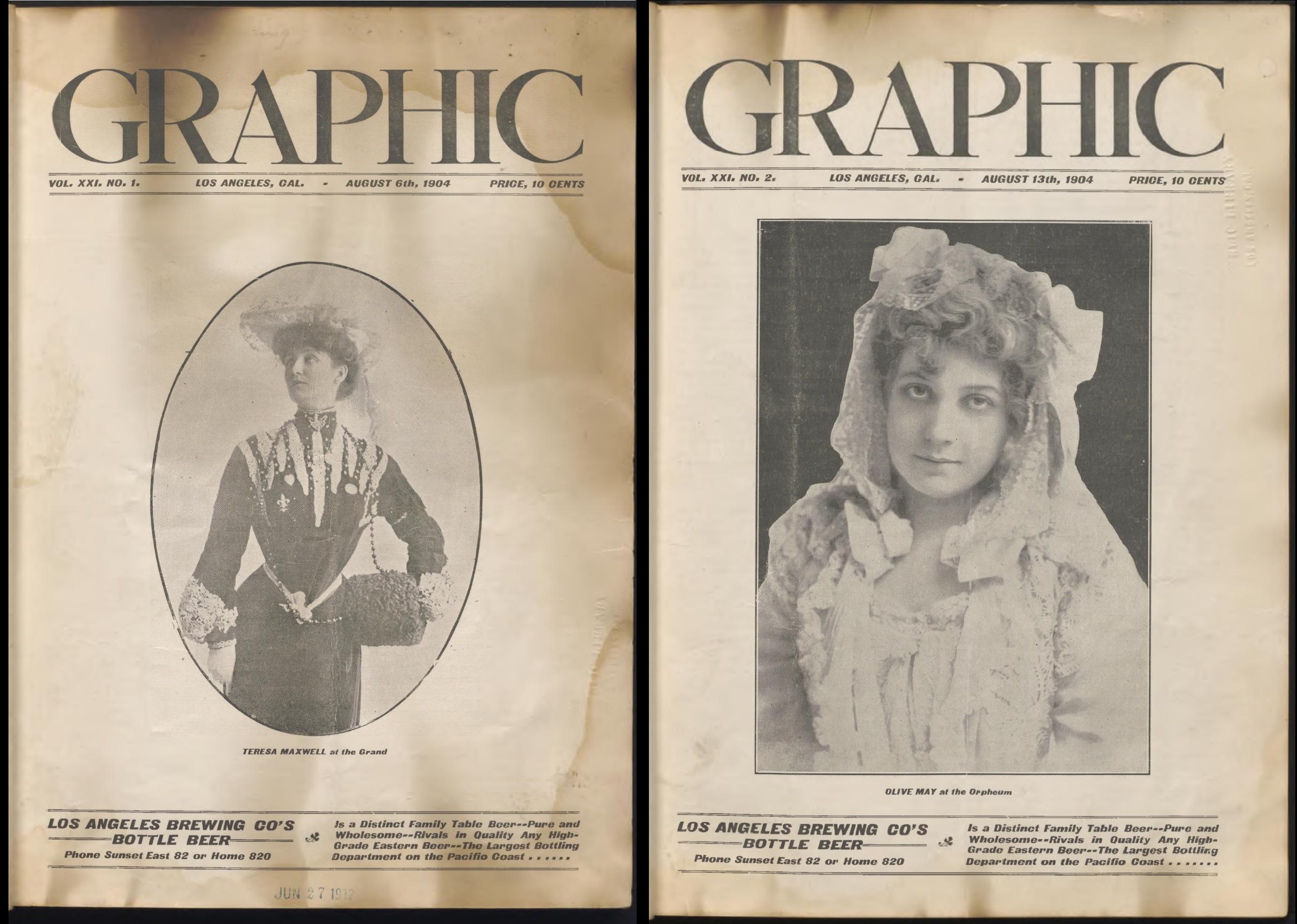
—Special Thank you to Kelly Wallace, Christina Rice, Amanda Charles, and Ani Boyadjian for their help with this post.
